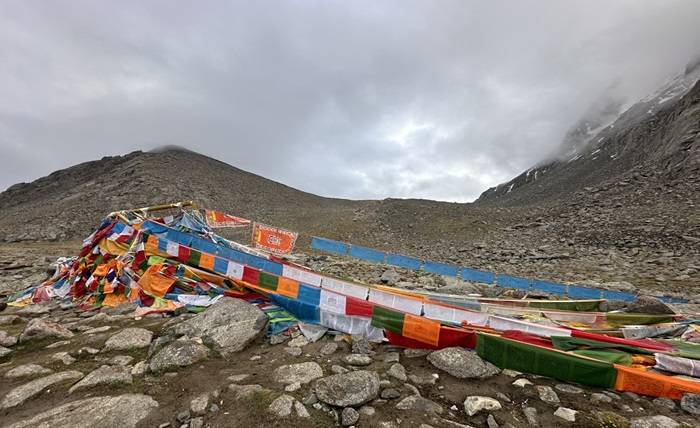Tibet, the roof of the world, is a land of rugged beauty and spiritual serenity. Among its myriad attractions, the high mountain passes stand out as the ultimate challenges and rewards for adventurous trekkers.
These high passes are not just physical obstacles but gateways to breathtaking vistas and profound experiences. If you’re planning a trek in Tibet, understanding these passes is crucial.
In this comprehensive guide, we’ll delve into the most remarkable high passes of the Tibet region, providing you with essential details to enhance your journey. Whether you’re an avid trekker or a curious traveler, this guide will help you navigate these majestic heights with ease.
1. Kora La Pass (5,560 meters / 18,274 feet)
The Kora La Pass is a highlight of the Mount Kailash Circuit Trek, one of the most sacred trekking routes in Tibet. This high pass, situated at an altitude of 5,560 meters (18,274 feet), offers an awe-inspiring view of Mount Kailash, a revered site for multiple religions.
Pilgrims and trekkers cross this pass as they complete the Kora, or circumambulation, of Mount Kailash. The trek from Dirapuk to Dolma La Pass takes you through this challenging yet spiritually rewarding pass. The Kora La Pass is a crucial point of reflection and prayer, making it an unforgettable part of the trek.
2. Zhangmu Pass (2,300 meters / 7,546 feet)
Situated at 2,300 meters (7,546 feet), the Zhangmu Pass is a key entry point into Tibet from Nepal. This pass is not as high as others but is crucial for those traveling overland from Kathmandu to Tibet.
The Zhangmu Pass connects the Tibetan town of Zhangmu with the Nepalese border town of Kodari.
It is a vital route for those undertaking the overland journey and offers a fascinating glimpse into the transition between the lush greenery of Nepal and the arid Tibetan plateau. The pass is an essential gateway for travelers seeking to experience Tibet’s unique landscapes.
3. Gyatso La Pass (5,220 meters / 17,126 feet)
The Gyatso La Pass, located at an altitude of 5,220 meters (17,126 feet), is a prominent feature of the Mount Everest Base Camp Trek in Tibet. This high pass is crossed during the trek from Tingri to Everest Base Camp.
The Gyatso La Pass provides stunning panoramic views of the Himalayas, including the towering Everest. It’s a challenging section of the trek, offering both physical demands and spiritual rewards.
The crossing of Gyatso La Pass is a significant achievement for trekkers and is celebrated with awe-inspiring views and a sense of accomplishment.
4. Nam Tso Pass (4,718 meters / 15,478 feet)
At an altitude of 4,718 meters (15,478 feet), the Nam Tso Pass is a significant high point on the route to Nam Tso Lake, one of Tibet’s largest and most picturesque lakes.
The pass is situated between Lhasa and Nam Tso, and the journey across it offers breathtaking views of the lake and the surrounding mountains.
The Nam Tso Pass is crossed on the way to the lake, where trekkers can enjoy serene landscapes and the spiritual ambiance of the region. It’s a popular spot for those looking to experience Tibet’s natural beauty and tranquility.
5. Lhakpa La Pass (5,220 meters / 17,126 feet)
The Lhakpa La Pass, also at 5,220 meters (17,126 feet), is another high pass on the Tibet-Nepal Overland Tour. This pass is often crossed during the journey from Shigatse to Lhasa.
The Lhakpa La Pass offers stunning views of the Tibetan Plateau and the surrounding peaks. The trek through this pass is both challenging and rewarding, providing trekkers with an immersive experience of Tibet’s dramatic landscapes.
The Lhakpa La Pass is a testament to the rugged beauty of Tibet and an essential part of the overland adventure.
6. Mayum La Pass (5,248 meters / 17,220 feet)
The Mayum La Pass, standing at an impressive altitude of 5,248 meters (17,220 feet), is a notable feature of the Lhamo Latso Trek.
This pass is a critical crossing point during the trek, connecting the rugged terrain of the Tibetan plateau with the mystical landscapes surrounding Lhamo Latso Lake.
The Mayum La Pass is renowned for its challenging conditions and breathtaking vistas. Trekkers crossing this pass are rewarded with panoramic views of the surrounding peaks and valleys, making it a highlight of the trek.
The Mayum La Pass is not only a physical challenge but also a spiritual milestone for many pilgrims, adding depth to the overall trekking experience.
7. Dolma La Pass (5,636 meters / 18,492 feet)
Dolma La Pass, reaching an altitude of 5,636 meters (18,492 feet), is one of the highest and most challenging passes in the Tibet region. This pass is a central feature of the Kailash Mansarovar Yatra, specifically during the Parikrama (circumambulation) of Mount Kailash.
Crossing Dolma La Pass is a significant achievement for pilgrims and trekkers, offering stunning views of the surrounding Himalayan peaks and the sacred landscapes of Kailash.
The pass is typically crossed on the second day of the Parikrama, and its high altitude demands careful acclimatization and preparation. The Dolma La Pass is a pivotal point of spiritual reflection, symbolizing a major hurdle overcome on the journey toward enlightenment and renewal.
Conclusion
Navigating the high passes of Tibet provides a profound adventure filled with spiritual and physical challenges.
From the awe-inspiring Dolma La Pass on the Kailash Mansarovar Yatra to the remote Mayum La Pass on the Lhamo Latso Trek, each pass offers unique experiences and stunning vistas.
Understanding these high passes is essential for any trekker or pilgrim preparing for a journey in Tibet. Embrace the challenge of these majestic heights, and let the beauty and serenity of Tibet transform your experience.

